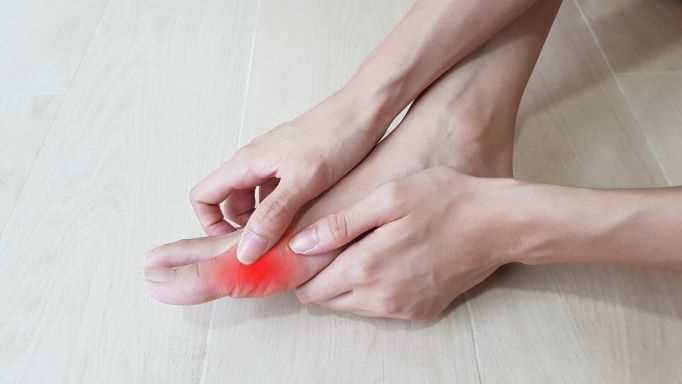
Advances in Gout and Joint Pain Treatment
An estimated four percent of people in the U.S. experience gout, and that number is steadily rising.[1] While many factors have contributed to the rising rates, one has been a failure to develop new, effective therapies. Gout can cause as severe a disability as rheumatoid arthritis, yet there are far fewer modalities to treat it. Many patients seek new ideas in pain relief for joints.
Thankfully, there are currently several drugs in development for gout that have shown promising results including high uric acid treatment. We’ll explore those shortly, but first, let’s review what gout is, how it’s diagnosed, and what treatment options are available at this time.
What is gout?
Gout is a common form of arthritis caused by the accumulation of urate crystals in the joints. This condition is characterized by sudden, severe attacks of swelling, pain, redness, and tenderness in one or more joints—most often the big toe. It can also cause; knee joint pain, tophi, gout flare in your hands, and other conditions related to gout pain.
Not only is gout painful, but if gout flares continually go untreated, the joints can become damaged. Additionally, untreated gout can make a person more likely to develop other serious health problems, including kidney stones, obesity, high blood pressure, cardiovascular disease, and diabetes.[2] As such, prompt treatment is of the utmost importance.
How is gout diagnosed?
In some cases, a doctor can diagnose gout based on your symptoms and the appearance of the affected joint. Some cases, however, aren’t so obvious. Doctors may need to order additional tests to confirm the diagnosis. These may include:
- Joint fluid test: A needle is used to draw fluid from the affected joint. This fluid is viewed under a microscope to look for urate crystals.
- Dual-energy computerized tomography (DECT): DECT scans use multiple X-rays of different strengths to produce an image that reveals urate crystals in joints. This test is a non-invasive alternative to a joint fluid test and has proven to be effective in diagnosing challenging cases of gout.[3]
- Ultrasound: Ultrasound is an imaging method that uses high-frequency sound waves to detect urate crystals in the joints.
- Blood test: Your doctor may suggest a blood test to measure uric acid levels in your blood. This test, however, is not always accurate.
What is the best treatment for gout?
While gout cannot be cured, it can be controlled with medications and lifestyle changes. Anti-inflammatory drugs, such as NSAIDs, colchicine, and corticosteroids, can reduce acute symptoms during flares. Other types of medications, such as allopurinol and probenecid, can help reduce the amount of uric acid in the body, thereby reducing recurrence and the risk of complications. High uric acid treatments can help with joint pain relief. There may also be OTC or over-the-counter treatments that may help with gout pain relief.
While the above treatments are effective for the majority of gout patients, about three percent of adults who suffer from gout aren’t helped by conventional therapy.[4]
New gout treatments in development
Fortunately, ground-breaking insights into gout biology have led to the development of new, potentially more effective treatments for both acute gout flares, gout pain relief, and lowering uric acid in the body.
According to Dr. Puja Khanna, an associate professor in the division of rheumatology at the University of Michigan, several drugs for gout are in the pipeline and show great promise in offering more effective treatment.[5]
Some of these drugs include verinurad and arhalfenate, which are agents that selectively target URAT-1 inhibition. There’s also topiroxostat, which is similar to the existing drug febuxostat. It’s been shown to reduce uric acid production by inhibiting xanthine oxidase.
Additionally, a drug called pegadricase is being studied and has been successful in phase one and phase two clinical trials.
Accessing new drugs through clinical trials
While these new drugs are not yet available to the public, those with gout can potentially access them through clinical trials. Clinical trials are a type of research on human health that evaluates the effects of a medical, surgical, or behavioral intervention. The people who receive experimental treatments in clinical trials are volunteers, meaning they choose to partake.
Participating in a clinical trial gives you access to cutting-edge treatment options that are not yet available to the public. As such, you could receive a medication that makes a positive difference in your gout symptoms and help with gout relief. These trials are free to participants and may include payment for time and travel.
If you’re interested in learning more about paid research studies for gout, sign up with Triad Clinical Trials today.
References:
- https://jamanetwork.com/journals/jama/fullarticle/2787544
- https://www.niams.nih.gov/health-topics/gout
- https://www.ncbi.nlm.nih.gov/pmc/articles/PMC5318147/
- https://www.rxlist.com/script/main/art.asp?articlekey=119722
- https://www.healio.com/news/rheumatology/20210813/influx-of-newer-agents-in-gout-pipeline-hold-promise-for-shifting-treatment-paradigm

